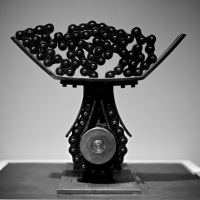Riedell 111 [skate package] review
Boot
- Materials -- The Riedell 111 boot consists of a soft vinyl outer material lined with a ___
- Wear -- This boot is not firm. If I were to give it a stiffness rating as it stands now, I would rank it around a 10-15. The boot initially offered a fair amount of support until after about two months of skating (see my style section). One of my skating acquaintances recently purchased a 111 and their boot felt significantly stiffer than my own. I would rate theirs around 5-10. They do not skate as hard or as often as I do/did so the stiffness claim will vary by style and duration (as expected). In the rink setting, I would not see this material being damaged easily however, I skate primarily outdoors. My first slip going downhill shredded the upper part of the outers on one of my boots (see figure 1). Sliding on rough concrete downhill didn't take the boot out of commission or significantly impact the skate-ability of the boot.
- note: the newer 111 may be stiffer than the one I purchased.
- Boot fit -- The shape of the boot is passable. They do not have a shape that holds the skater's foot; they cannot "fit like a glove." (This analogy works best when you know what good fit it) These boots only came in full sizes.
- I am a 12.5W (US). I tried a 12 and it was too small all around. The boot I ended up getting was a size 13. The boot fit but there is a significant amount of space in the toe-box area such that when doing movements on my toes (front two wheels), my foot drops/slides to the front. A similar thing happens when trying to skate on the heels e.g. heel-heel spin. Ultimately technique overcame the hurdle, however, there's a point in every skater's journey when the skater should not compromise on fit.
Plate
The plate included in the package is the Powerdyne Thrust plate (PTp). While it is made of nylon, it has stood the test of time as I have skated in a few seasons (during the hottest of summer days to some very cold, below 0°C. Compared to a metal plate that I own, I am able to get a reasonable performance but the combination of my style and skate frequency, I much prefer a metal plate. I never changed the cushions on the PTp over the 2.5y I skated on them. Apparently, I had them very tight which would restrict the action I would get back from them. I didn't really notice that I was being held back in some way. About 1.5 years in, I loosened them [after being told again and again and again] that I should "loosen my trucks." Riding loose lead to a sloppy experience where it was unnecessarily difficult to do some of my more precision-demanding movements.
I recently tried replacing my cushions but have discovered that I cannot put them back together. The kingpin is no longer seated in the plate and screwing the nut is not possible. I will ride this loose monstrosity in my left heel until I die. I think this is the fate of nylon plates that get skated on aggressively. The parts that would hold the kingpin into the plate effectively stripped the area that it was seated in.
Wheels
Riva 96a These wheels are the inexpensive indoor wheel option by Riedell's sub brand, Radar. They are fine for beginners. I did wear them down fairly quickly since I danced in them. See the second attached image. You can read about wheels for rhythm dancing and other upright dance styles. [Jam skating (style) is not addressed.]
My style:
My style is slalom X rhythm. The key movements are weaving in lines, tight turns, and direction changes. This boot is not perfectly suited for my personal style. While I can do most of what I want to do, I find myself falling missing some inputs due to response being off when I press into the boots for some turns. The material is not firm enough for my sharper turns and harsh direction changes. For every-day skating, they perform very well.

